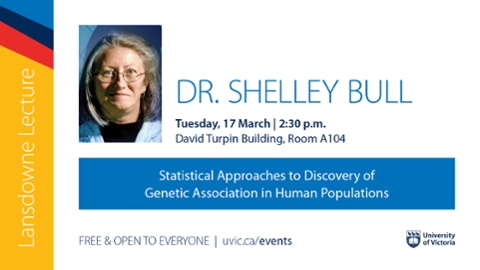** POSTPONED ** Landowne Lectures - Shelley Bull
***** POSTPONED *****
Shelley Bull of Lunenfeld-Tanenbaum Research Institute, Sinai Health System will be giving a Public Lansdowne Lecture on "Statistical Approaches to Discovery of Genetic Association in Human Populations", Tuesday, March 17 at 2:30 pm in David Turpin Building A104.
She will be giving a Department Lansdowne Lecture on "Challenges in High-dimension Genetic Data Analysis", Wednesday, March 18 at 2:30 pm in Clearihue Building A206.

Abstracts:
Statistical Approaches to Discovery of Genetic Association in Human Populations
Human genomic DNA is composed of approximately 3 billion nucleotides in a linear string, organized into 23 chromosome pairs. Genome-wide association study (GWAS) analysis takes a comprehensive agnostic screening approach to discover genetic variants that are associated with complex traits such as physiological measures or disease status. Typically, the analysis proceeds by examining association of a trait with each genetic variant, one at a time. This involves making several million statistical tests across the genome. Motivated by genetic architectures in which analysis of sets of variants within a genomic region can uncover associations missed by single-variant analysis, in this talk I will describe a two-stage strategy for region-level genetic association testing. In the first stage, genomic regions are identified by computationally partitioning each chromosome into blocks according to local correlation structure known as linkage disequilibrium. Within each of the blocks, statistical association analysis then proceeds in stage two using multiple-variant methods. I will discuss some of the analytic issues we face in applying this strategy in association analysis of quantitative traits and disease status using dense GWAS genotype data.
Challenges in High-dimension Genetic Data Analysis
Progress in dissecting the genetic determinants of complex human traits requires cost-efficient genomic technologies, biological knowledge accessible in open data resources, and computationally feasible statistical methods that reliably infer association in the context of high-dimensional multiple testing. It has been estimated that there are 8 million common single nucleotide polymorphisms (SNPs) with variants occurring at a frequency of at least 1% in a population. Well-developed array technologies, widely used in genome-wide association studies (GWAS) of complex traits, can genotype individuals at 1 million SNP positions chosen to capture common variation. Emerging next generation sequencing (NGS) technologies generate genotypes at the nucleotide level, including rare variants, and enable imputation of 8-9 million high-quality unmeasured SNPs from 1 million genotyped SNPs. At the same time, investigators are focussing on use of population biobanks with many traits available on each individual. High-dimensional GWAS, NGS, and trait data, together with variant, gene, and biological pathway annotation resources are increasingly available for data mining and meta-analysis, but present major analytic challenges including joint analysis of multiple data types, use of biological knowledge to inform statistical modelling, and choice of study design. In this talk, I will highlight some of these challenges in two settings: joint modelling of multiple traits in a longitudinal study of unrelated individuals; and discovery of rare mutations in families ascertained on disease status.
